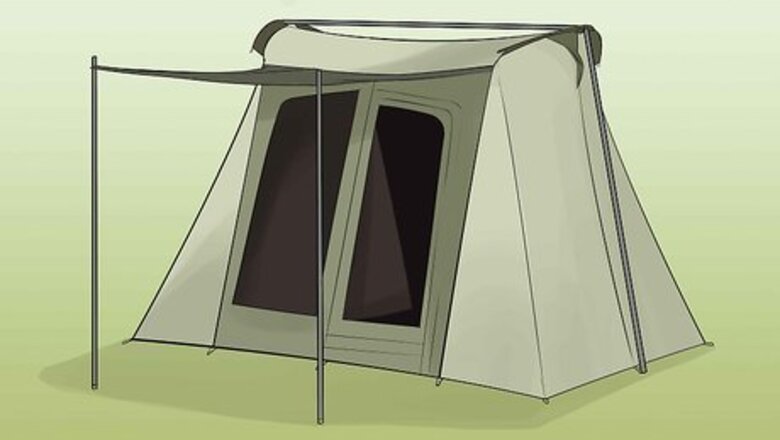
views
Choosing a Tent
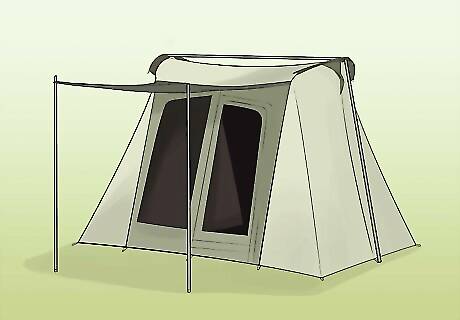
Get a durable tent. A canvas tent is the most durable option, but they can be expensive. Canvas tents will keep out the rain, and they won't get as hot inside because the fabric is breathable. If you're on a budget, look for a nylon tent that comes with a rainfly to keep you dry when it rains. If you go with nylon, you should apply a waterproof treatment to the outside of the tent before you use it. Keep in mind that canvas tents are heavier and harder to set up than nylon tents. If you think you'll be moving around a lot, a nylon tent may be your best option.
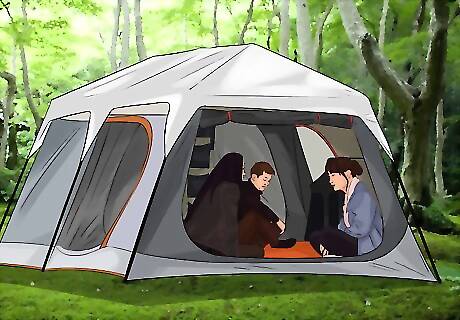
Choose a large tent so you have room to spread out. Look for something designed for at least three people, if not more. Don't be afraid to go with a six or seven person tent if you plan on living in it for a while. Even if you're the only person who will be using the tent, it may be wise to get one that's sized for at least two people. That way, you can store your gear inside your tent and won't have to go outside every time you want to retrieve some equipment.
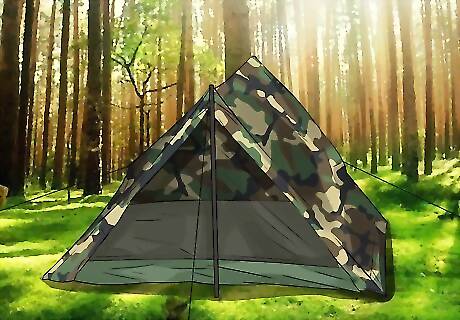
Get a camouflage tent if you’re trying to be discreet. If you’ll be setting up camp in a busier area, or you’re just worried about people finding your tent, a camouflage tent will make it easier to hide your new home. Avoid traditional camping tents that come in bright colors like blue, red, and yellow.

Get a pop-up tent if you’ll be moving around a lot. It’s easiest to live in a tent if you stay put in one place, but sometimes that’s not possible. If you plan on changing locations a lot, go with a pop-up tent that you can easily set up and disassemble.
Picking Somewhere to Live
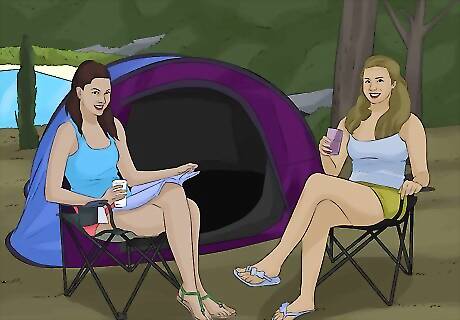
Ask a friend or family member if you can camp out in their yard. This is a great option if you only plan on living in your tent for a short period of time. Let them know it’s only temporary and offer to help out with chores around the house. They may let you use their bathroom and cook in their kitchen.
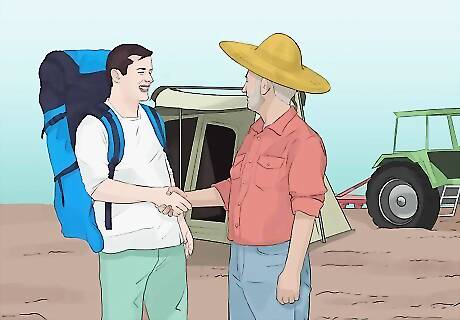
Make a deal with a farmer so you can set up your tent on their land. Offer to work on their farm in exchange for them letting you live in your tent there. Since you'll be living on private property, you won't have to worry about being bothered by strangers. Visit https://wwoofinternational.org to look for local farmers offering a place to stay in exchange for work.

Put up your tent at a free campsite. Look online for nearby dispersed campsites that are free. At a campsite, you’ll have a flat, cleared-out spot to set up your tent, and maybe even a fire pit. Some campsites also have communal bathrooms you could use. Make sure you check on the campground's website if they require reservations. Find out how long you’re allowed to stay at the campsite before you go there. Most dispersed campsites have limits on how long you can stay. These limits can range from a week to several weeks. After the limit is up, pack up your tent and relocate to a different campsite. Try to find free campsites that are open to the public year round.
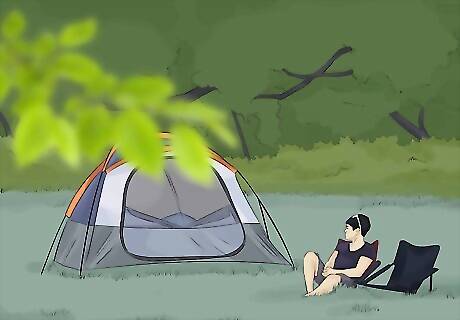
Look for a secluded spot if you have no other options. Try to avoid busy cities and parks. Make sure you’re not setting up your tent on private property. Investigate the area carefully and check for any signs that say “private property.” Keep in mind that even though a spot isn't privately owned, you still might not be able to set up your tent there. Choose a remote place in the woods or countryside where you'll be less likely to be bothered by the police or park rangers.
Setting up Your Tent

Set up your tent on high, flat ground. Avoid setting up your tent on an incline or at the bottom of a slope; your tent could flood if it rains. Clear any rocks or branches on the ground where your tent will go.
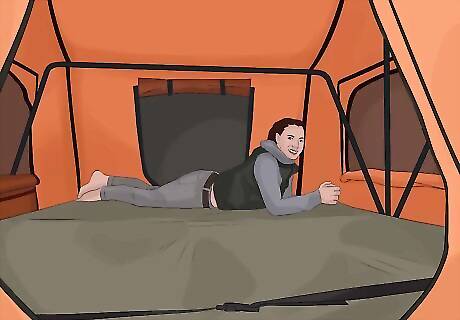
Lay down something comfortable for flooring. A carpet or padding will help you sleep more comfortably, and it will insulate you from the cold ground. If you can't afford a carpet or padding, use a thick blanket or comforter instead. Towels are also good to use for padding because they'll absorb any liquids that get into the tent and keep you and your belongings dry.

Keep all of your belongings organized. Separate your clothes, cooking supplies, and bathroom stuff in different plastic containers or bags. Life in your tent will be more manageable if everything has a specific place it’s supposed to go. When you’re not sleeping, roll up your sleeping bag and blankets so you have more room in the tent.

Build a fire pit outside of your tent. A fire pit will give you a place to cook food, dry your clothes, and stay warm when it’s cold outside. Make the pit 6 inches (15.2 cm) deep and 2 feet (0.6 meters) across. Pile dirt and rocks around the fire pit to prevent fire from spreading.
Finding Ways to Eat

Maintain a healthy diet. Eat a lot of fruits, vegetables, and whole grains like whole wheat bread. Avoid foods with a lot of salt, sugar, and fat. When you're at the grocery store, look for foods that say "less sodium" or "fat free." Drink a lot of water and avoid sugary drinks like soda. Make sure you're getting enough calcium. Dried fruits, nuts, beans, broccoli, and dark greens all are good sources of calcium. You can also take a daily vitamin with calcium in it to supplement your diet.
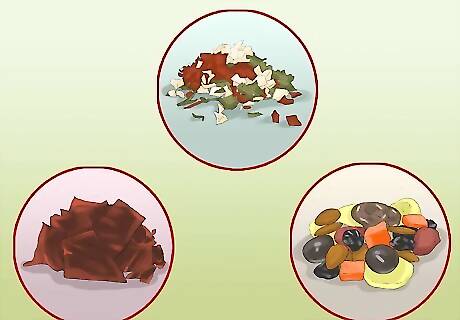
Eat dehydrated foods. Dehydrated foods are easy to eat because you don't have to cook them. Stock up on dehydrated foods like beef jerky, dried fruits, and dried vegetables.

Get freeze-dried foods. Freeze-dried foods have a long shelf-life, and they don't require refrigeration. Keep a stockpile of freeze-dried foods in a plastic container. When you're ready for a meal, just add hot or cold water to some of the freeze-dried food and it will regain its shape, taste, and nutritional value.
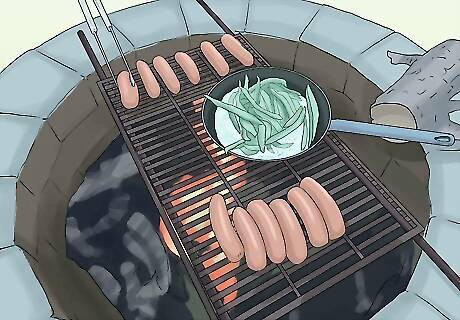
Cook food over a fire. Start a fire in the fire pit outside of your tent. Once the fire is going, set a metal grate over the flames so it’s flat. Place a pan or pot on top of the grate and put your food inside and wait for it to cook. You can also heat liquids this way. Keep in mind it may take longer for your food to cook than with a regular stove.
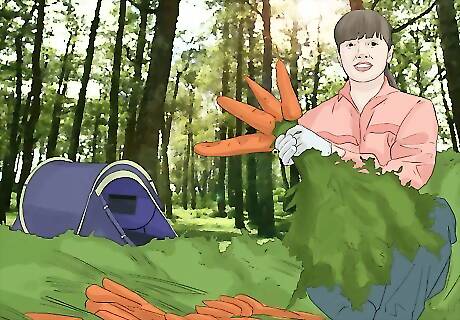
Grow your own food outside your tent. Clear a small section of land outside your tent to plant a garden. Get cheap seeds from your local gardening center and plant them in the ground, following the planting instructions on the packaging. Grow foods that are low maintenance, like lettuce, radishes, onions, potatoes, tomatoes, and beans. Keep in mind it will be a while before you can harvest anything you plant. Use a garden as a way to supplement your diet, not as your main food source.
Keeping Yourself and Your Tent Clean
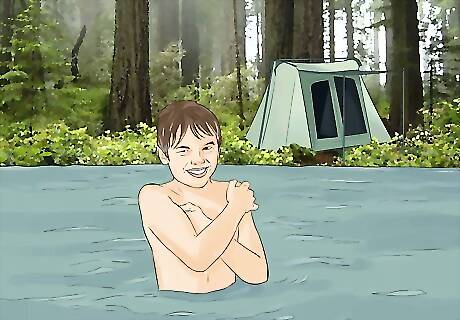
Bathe regularly. If your tent is set up near a lake or stream, take a bath there. If you’re not living near fresh water, heat up some water over a fire to clean yourself with. Use a bar of soap and a clean rag to wash your body. If you don’t have shampoo, use the soap to clean your hair. To conserve water, have a stash of cleaning wipes in your tent. Whenever you’re feeling dirty, wipe your body down with the wipes.
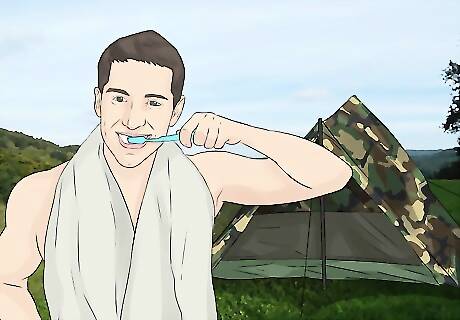
Practice good oral hygiene. Have a toothbrush and toothpaste in your tent and brush your teeth twice daily. Take a sip of water to rinse your mouth out after you brush and spit it outside of your tent.
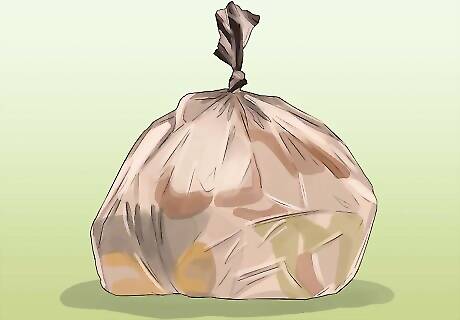
Stow your trash in sealed bags before you can dispose of it. Put all your wrappers and food scraps in sealable plastic bags so wild animals aren’t attracted to your tent. Keep these sealed bags organized in a larger trash bag. When the trash bag gets full, prepare to take it somewhere you can properly dispose of it, like a nearby dumpster or trash can.

Go to the bathroom at least 200 feet (61 meters) from your tent. If you don’t have access to a toilet or outhouse, look for a discreet area that is away from any nearby water sources. For defecation, dig a hole that is 6-8 inches (15-20 cm) deep and fill it in with dirt and soil when you’re finished. Bury toilet paper in the hole.
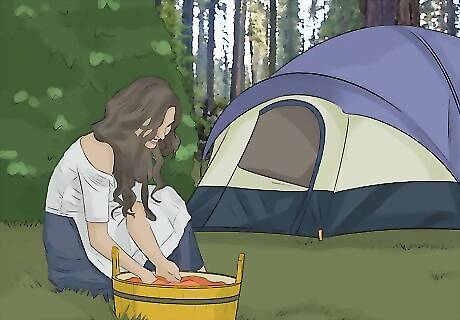
Wash your clothes in a large bucket or sealable plastic bag. Fill the bag or bucket with hot water and put your dirty clothes inside. Dump in a little laundry detergent or dish soap and mix the clothes around in the water for several minutes. Let your clothes soak for ten minutes. Dump out the sudsy water and rinse your clothes with clean water. Hang them up to dry. Make your own clothesline for drying your wet clothes by hanging a wire between two trees.

















Comments
0 comment